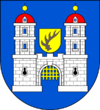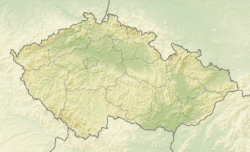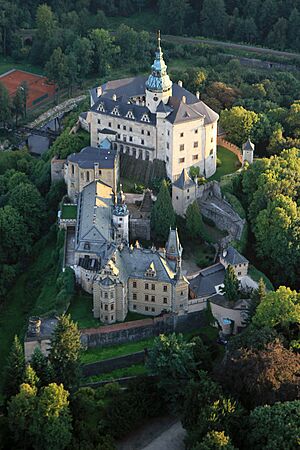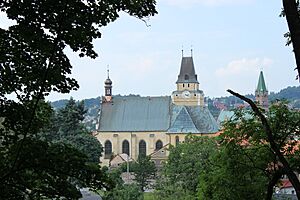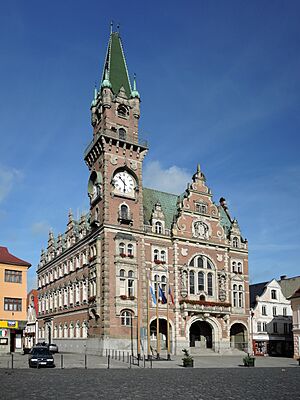Frýdlant facts for kids
Quick facts for kids
Frýdlant
|
||
|---|---|---|
|
Town
|
||
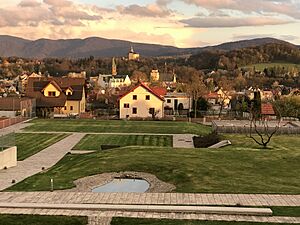
View of Frýdlant
|
||
|
||
| Country | ||
| Region | Liberec | |
| District | Liberec | |
| First mentioned | 1278 | |
| Area | ||
| • Total | 31.61 km2 (12.20 sq mi) | |
| Elevation | 295 m (968 ft) | |
| Population
(2024-01-01)
|
||
| • Total | 7,388 | |
| • Density | 233.72/km2 (605.34/sq mi) | |
| Time zone | UTC+1 (CET) | |
| • Summer (DST) | UTC+2 (CEST) | |
| Postal code |
464 01
|
|
Frýdlant is a town in the Czech Republic, located in the Liberec Region. It is also known as Frýdlant v Čechách. About 7,400 people live here. The old town center is very well kept. It is even protected by law as a special historic area.
Contents
Town Parts and Location
The small villages of Albrechtice u Frýdlantu and Větrov are part of Frýdlant.
Where is Frýdlant?
Frýdlant is about 17 kilometers (11 miles) northwest of Liberec. It is in a unique area called the Frýdlant Hook. This area is very close to the border with Poland. Most of the town is in the Frýdlant Hills. The southern part reaches into the Jizera Mountains. The highest point in Frýdlant is Špičák hill, which is 724 meters (2,375 feet) high. The Smědá River flows right through the town.
History of Frýdlant
Early Times: 6th to 16th Centuries
People from Slavic tribes, who came from Lusatia, first settled this area around the 6th century. In the 13th century, a family called the Ronovci owned the local castle. But King Ottokar II of Bohemia took it back.
The first time Frýdlant was mentioned in writing was in 1278. A man named Rulko of Birbstein bought the castle and land from the king. Important trade routes passed through this area. These routes connected to places like Görlitz and Lusatia. By 1381, a moat and strong walls were built around the town to protect it. Most of these walls were removed in 1774.
During the Hussite Wars (1419–1434), Frýdlant was taken by the Hussites in 1428. The town was attacked several times between 1428 and 1433. After the last Birbstein family member died in 1551, the castle went to Emperor Ferdinand I, Holy Roman Emperor. In 1558, the Redern family bought the castle. They helped the town's economy grow by starting linen cloth production. An Italian architect named Marco Spazzio di Lancio made the castle bigger in the 16th century.
Later Years: 17th to 19th Centuries
In 1620, the Redern family lost their property because they opposed Emperor Ferdinand II, Holy Roman Emperor. Frýdlant then went to Albrecht von Wallenstein. He became the Duke of Frýdlant. Wallenstein brought Catholicism back to the area. After he was assassinated in 1634, Frýdlant went to Matthias Gallas in 1636. This was a reward for his actions against Wallenstein.
At the end of the Thirty Years' War, Swedish soldiers took over the castle. They built new defenses. Many people who had left the area because of religious issues did not return. The Gallas family owned the estates until 1757. Then, the Clam-Gallas family took over.
Around 1800, the Clam-Gallas family opened the castle to the public as a museum. This was very early for a museum! In 1813, Napoleon and his soldiers were in the town, which was hard on the local people. In the 19th century, a textile industry grew in Frýdlant. A special column was built in 1899 to remember people who died from plague epidemics. The town also survived several big fires.
In 1875, a railway line was built from Liberec to Frýdlant. More train lines followed soon after.
20th Century Changes
Frýdlant was part of Austria-Hungary until 1918. The Clam-Gallas family owned the castle until 1982. After the 1938 Munich Agreement, Nazi Germany took over the town. It became part of a region called Reichsgau Sudetenland.
After World War II, Frýdlant became part of Czechoslovakia again. Many German-speaking people were asked to leave. Czech settlers then moved into the town.
In 2016, some treasure hunters claimed that items from the famous Amber Chamber were hidden in the castle cellars. They believe these items, stolen by the Nazis, are still there. However, they have not been able to search for them.
Population Over Time
Frýdlant has seen its population change over the years. In 1869, there were about 6,367 people. By 1910, the population grew to 9,337. After World War II, the number of people living in Frýdlant decreased. In 2021, the town had about 7,255 residents.
Getting Around Frýdlant
Frýdlant is on two local railway lines. These lines connect Liberec to Černousy and to Nové Město pod Smrkem.
Places to See in Frýdlant
Frýdlant Castle
The castle is a large complex with a Gothic castle and a Renaissance castle. You can see many interesting things inside. There are exhibits about Albrecht von Wallenstein and the Thirty Years' War. There is also a large collection of 1,000 weapons used for fighting and hunting. The castle has a chapel, a Knights' Hall, and rooms where the count and countess lived. You can even see a working kitchen!
Church of the Finding of the Holy Cross
Italian architects built the Church of the Holy Cross in the mid-16th century. It has a mix of different building styles because it was built over many years. A special chapel for the Redern family tomb was added in 1566. A mausoleum for the Redern family was built in 1610.
Town Hall and Museum
A new town hall was built in 1893 in the center of Frýdlant. It was designed by architect Franz Neumann. Inside, you can see a statue of Albrecht von Wallenstein. The building has beautiful stained glass windows. Outside, there are statues that represent Self-Sacrifice and Justice. Today, the Frýdlant Town Museum is on the second floor. It has exhibits about the town's history and old discoveries.
Old Town Walls
You can still see parts of the old town walls today. There are also pieces of three tall, square towers. The walls are almost round and were built from local basalt rock.
Famous People from Frýdlant
- Alexander Bittner (1850–1902), a scientist who studied old fossils and rocks.
- Josef Blösche (1912–1969), a soldier.
- Otto Kade (1927–1980), a German scholar who studied translation.
- Jan Budař (born 1977), an actor, director, and musician.
- Iva Mocová (born 1980), a footballer.
- Jan Rajnoch (born 1981), a footballer.
- Tomáš Plíhal (born 1983), an ice hockey player.
- Karolína Bednářová (born 1986), a volleyball player.
- Ladislav Šmíd (born 1986), an ice hockey player.
- Antonín Hájek (1987–2022), a ski jumper.
Sister Cities
Frýdlant is connected with other towns around the world. Many of its sister cities share the historic German name Friedland.
See also
 In Spanish: Frýdlant para niños
In Spanish: Frýdlant para niños


